It’s cool right now to rag on the 5.56x45mm cartridge.
Maybe it’s because most people just want something new and don’t necessarily “need” a new one. Which I sure do understand!
If you feel like you need a bigger caliber, there’s a lot of useful options and a recent flood of gimmicks that have come out. It’s getting hard to tell the two groups apart.
But don’t worry…
We’ll go over few of the best AR-15 cartridges and calibers that offer more oomph than the standard 5.56 NATO, along with all their positives & negatives:
- .300 Blackout
- 6.5 Grendel
- 6.8 SPC
- .458 SOCOM
- .50 Beowulf
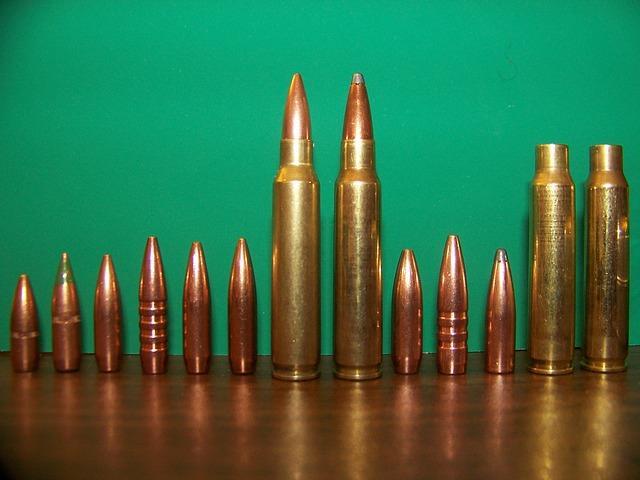
How to Choose an Alternative AR-15 Cartridge/Caliber
Choosing a rifle cartridge isn’t as simple as just picking the one that’s the most powerful or the coolest.
Although the most common upgrades, .300 BLK, 6.5 Grendel, 6.8SPC, and the big boys .458 SOCOM and .50 Beowulf are all cooler and more powerful than the 5.56.
Picking the right rifle cartridge can have real world consequences that affect lives and can make you look like an idiot at the range (and your bank account) if you don’t pick the right one for your purpose.
The basic categories to choose a cartridge involve compromises of power, cost and usefulness…just like deciding on the perfect car.
- Power: this is the biggest balancing act and involves the most real world experience
- Flexibility: a feature that sounds great in theory but can be hard to pull off
- Availability: more is always better here, consider not only the supply but also the demand
- Cost: cheaper is always better, the cheapest rounds tend to be the best and most widely used
Pursuit of Power
The power of the cartridges involves two main types of power: penetration and velocity. It may seem like these two types of power are the same thing, and while they are related…they are two different beasts.
Defining the exact killing power of a cartridge is hard to nail down in a scientific sense. Numbers such as the kinetic energy of a round can tell you a lot about a round but it’s certainly not the only important think.
You can think of the velocity of the bullet like the engine on a truck. It produces all the power/force necessary for the truck to move, but the transmission is what connects the engine to the wheels.

Without the transmission the truck won’t get off the line. Bullet weight is the “transmission” that causes penetration.
Velocity is a great thing but without an adequately heavy bullet, velocity is irrelevant. Bullet weight is what causes penetration and lethality.
Cartridges that throw heavy bullets at medium velocities are more powerful than a lighter bullet traveling faster because light bullets lack the ability to penetrate and cause damage.
Just like you wouldn’t use a Ford Fiesta to move a boat you wouldn’t get in an 18 wheeler to drive to work, balance of power is they key and depending on what you’re shooting at you may need far less than you think.
Flexibility Fetish
If you’re on a budget, just getting started, or just want an all-around gun…flexibility is important.
I realize this is a pretty nebulous term because no one rifle can do everything well, but some guns can do most things well.
Gun are really defined by their cartridge, so if you want a gun that will do most things, focus on a round that serves well. Also keep in mind that with the AR-15 you can usually get a new cartridge or caliber with a new upper and magazines!
You just can’t get more flexible than that!
I also recommend to not be tempted to buy too powerful of a cartridge for the job you have.
There’s a time and place for a big thumper like a .50 Beowulf (engine blocks anyone?) and just thinking it’s plain cool is a valid enough reason.
Remember it can be tempting to buy a stout round to show off but you’re going to pay for the extra materials in the round and recoil to your body.
Narrow down why you’re upgrading your AR-15 and you’ll probably find it’s for one of these jobs:
- Home defense
- Hunting
- Competition shooting
For all three of these remember that bigger than the 5.56 means better than the 5.56. How big you need to go is determined by the job you have in mind.
Availability & Cost
If you buy a gun you have to feed it.
And the cost of ammo is one of the single biggest factors of how often you shoot. Not sure where to buy…see our favorite place to buy online.
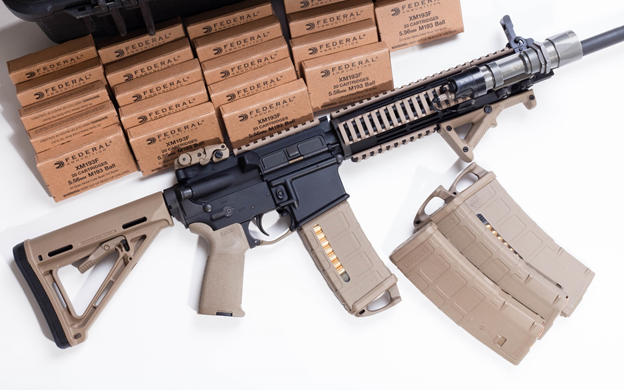
The cost also has to include the necessary modifications you need to make the gun run right. It may be tempting to build one yourself but remember that these rounds can be finicky. If the upper you build doesn’t run right you’re out of luck.
But don’t worry…we’ll recommend some solid uppers for each new caliber.
When the cost of ammo goes up or you just can’t find it you won’t be able to shoot. The only cartridge here that is really common is .300 BLK with 6.8 SPC coming in at a close second.
Consider how you’re going to find ammo during a scare a high demand can be just as bad as a low supply. Really consider this because shipping ammo can be banned at any moment. Just ask California, it can be a fight to fix once it happens, remember to be vigilant and ready to resist attempts to take away your rights.
TL; DR
NONE, of these cartridges are ever going to supplant the 5.56 as the standard for NATO or police forces causing the prices of these cartridges to drop. Yes, the costs of these rounds have come down but there is trillions of dollars worldwide behind the 5.56 and no amount of improvements are going to change its use worldwide.
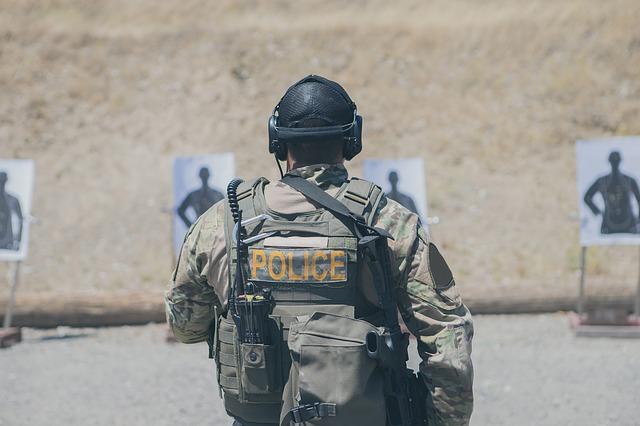
Sneak Peek
| Cartridge | Cost Per round | Changes to rifle | Uses |
| .300blk | $$ | Barrel | Home defense, hunting, target shooting |
| 6.8 SPC | $$ | Barrel, Bolt, Magazines | Competitive shooting, hunting |
| 6.5 Grendel | $$$ | Barrel, Bolt, Magazines | Competitive shooting, hunting |
| .458 SOCOM | $$$$ | Barrel & Bolt | Hunting |
| .50 Beowulf | $$$$ | Barrel & Bolt | Hunting |
Ballistic Comparison
| Cartridge | Velocity* | Energy** | Drop at 300 yards*** | Effective Range |
| .300blk | 125gr @ 2200fps | 1300ft-lbs | -25” | 350 yards |
| 6.8 SPC | 110gr @ 2500fps | 1500ft-lbs | -19” | 450 yards |
| 6.5 Grendel | 120gr @ 2450fps | 1600ft-lbs | -18” | 450 yards |
| .458 SOCOM | 300gr @ 1800fps | 2100ft-lbs | -53” | 200 yards |
| .50 Beowulf | 400gr @ 1800fps**** | 2878ft-lbs**** | -50” | 200 yards |
*Max loading from Nosler Reloading manual **At muzzle ***Sighted dead on at 100 yards ****According to Alexander Arms
Ready?
.300 AAC Blackout (.300 BLK)
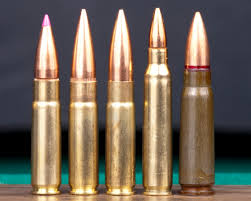
The .300 BLK was born out of the necessity to have a replacement for the sub-machine gun MP5SD which shot the pistol 9mm. It needed to be based on the M4 rifle, it needed to match or exceed a subsonic 9mm bullet, and it needed to be as quiet as possible.
Advanced Armament Company (AAC) took a .223 case, blew the mouth out to .30 caliber, and filled it with pistol powders.
BAM!
You now have a juiced up .30 caliber cartridge for your AR-15 that needs only a barrel change. No difference in magazines, lower receivers, or bolt carriers.
It is currently the only semi-auto cartridge that will reliable feed both supersonic and subsonic ammunition without hiccups.
Pros & Cons of .330 BLK
The really awesome things about .300 BLK is its performance out of a short barrel and the ability to shoot subsonic ammo with zero problems.
The .300 BLK was designed around a 9-inch barrel and it gets roughly 95% of its full potential with that barrel. Making it the absolute best cartridge for short barreled rifles and suppressed guns.
Check out our recommended Aero .300 BLK complete upper receivers.
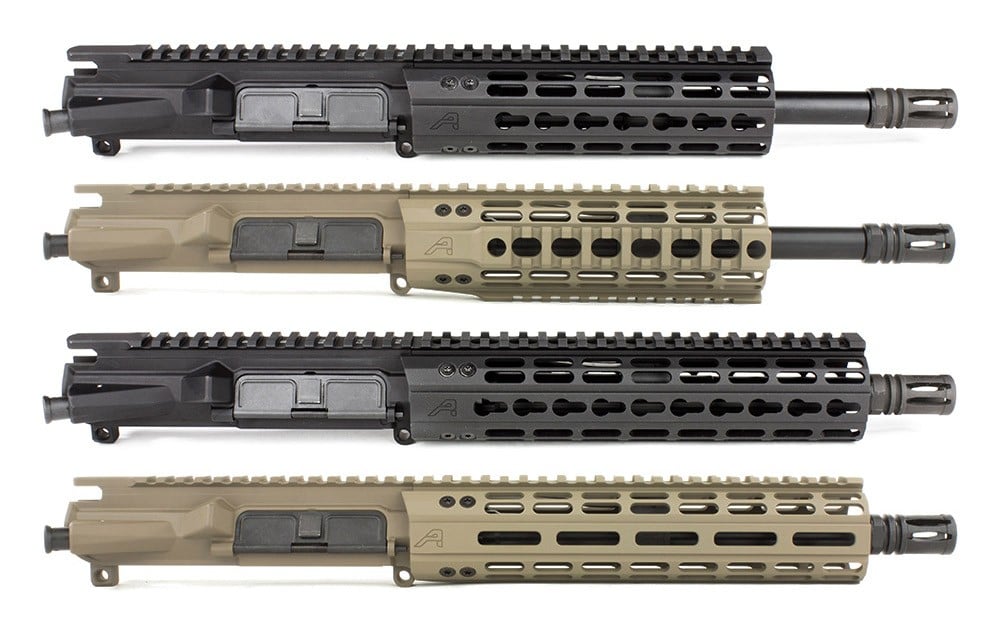
It is an ideal home defense gun with subsonic ammunition because it’s hearing safe if you use a suppressor.
If you’ve never lit off a gun, let alone a long gun, in a confined space I will personally attest that you WILL have hearing damage!
The problems with over penetration of the .300 BLK subsonic rounds take a back seat to the guaranteed hearing loss that will come out of a confined space shooting.
It isn’t perfect though, the suppressed rounds aren’t effective past 75 yards and none of the rounds have much steam after 250 yards. This is really a 300-yard maximum gun, mostly because of the excessive drop that occurs after you get past three football fields.
6.5 Grendel
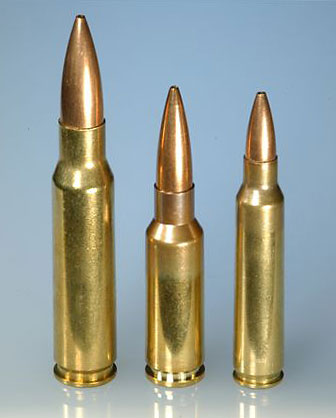
The 6.5 Grendel made its debut at the Blackwater Training Facility in North Carolina in the summer of 2004.
The idea behind it was to neck down the 7.62×39, the round made for the original AK-47, to .264 caliber to take advantage of the favorable ballistics of the 6.5mm bullet.
Pros & Cons of 6.5 Grendel
The advantages of the 6.5mm bore are the extremely high ballistic coefficient and the extremely high sectional density. These two qualities make this round out perform the 7.62 NATO in both terminal and exterior ballistics.
It shoots flatter, stays supersonic longer, penetrates deeper, and has less recoil than a 7.62 NATO.
This sounds like an infomercial but the numbers are there. This round performs best for hunting and competitive shooting.
As a tactical round for home defense it’s too expensive, around $.90-1.20 a round. It also offers no advantages within 300 yards. And it’s hard to find uppers with under 20″ barrels.
The main downsides of this round is the high barrel erosion, high cost of ammunition, and difficulty finding magazines. Even basic parts like bolts and barrels are expensive. A Grendel bolt can run you over $300.
The weird magazines are banana shaped like an AK’s, which isn’t inherently bad, it’s just awkward with an AR-15 lower receiver. The 6.5mm bore burns out quickly but this isn’t normally a problem because the ammo is rare and usually expensive.
If all this doesn’t phase you…check out some 6.5 Grendel Uppers.
6.8 SPC
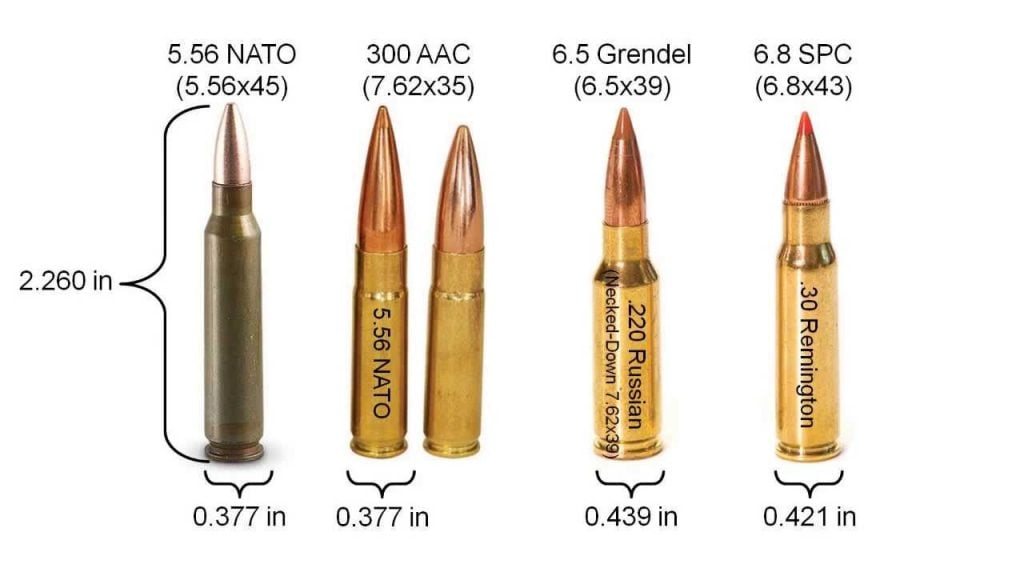
This round was developed as a long range option in the M4 for the Army’s marksmanship unit. They needed an exhibition round that would work well with the M4 to shoot in competitions and light field use.
What we do know is it was put up against the .300 BLK and 6.5 Grendel for replacement of the 5.56. While it performed admirably at ranges further than 250-yards, there was no practical point for the military using it since engagements were usually less than that.
Pros & Cons
This is a very cool round and it’s calling card is as a short range hunting round that shoots further than the .300 BLK and hits harder than the 5.56.
It’s a .270 caliber bullet right around 115gr that clocks in around 2600fps. It’s true that it carries 40% more energy than the 5.56 but the real advantage is the extra penetration and ballistic coefficient that comes with the extra bullet mass and cross section.
The downside to the 6.8 SPC is the availability of magazines.
Standard mil spec mags won’t work, because the feed lips and follower are different to accept the wider case.
Of course the barrel and bolt have to change but you only need one of each, and they can be bought in a package like this one, while multiple magazines can be hard to track down.
.458 SOCOM
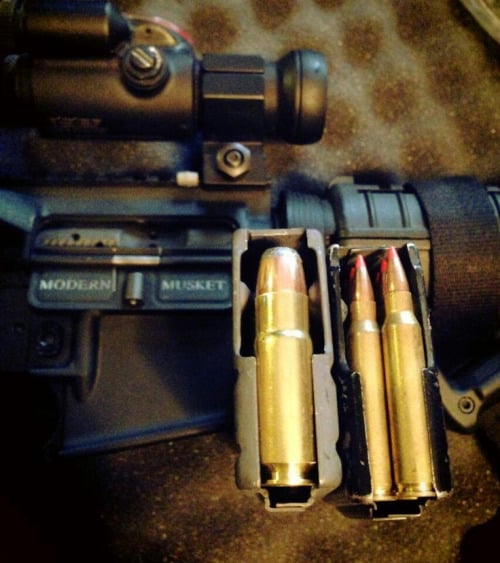
The best of the big woods thumpers, the .458 SOCOM was developed to have serious close quarters battle (CQB) stopping power for special operations forces.
The reason this cartridge beats out the other big bore AR-15 cartridges is because of the short barreled performance and availability of bullets in .458 diameter.
Pros & Cons
The .458 is a necked down .50 AE (of Desert Eagle fame) case which opens it up to a multitude of .458 bullets. It also uses fast-burning powders and heavy bullets that make it ideal for SBR’s and suppressors.
Unlike the .300 BLK whose subsonic rounds are a poor choice for hunting, the .458 throws 350gr+ slugs that can be used out to 75 yards for hunting thin skinned game.
With subsonic ammunition you get performance on par with a hot rodded .45 Colt and with supersonic rounds you get .45-70 glory wrapped in AR-15 clothes.
The .458 SOCOM saw limited use in the middle east for CQB operations because it throws a huge man stopper of a round in a small package and can be suppressed easily because of its short barreled performance.
Radical Firearms makes some great .458 SOCOM uppers.
.50 Beowulf
Coming from the minds that brought the 6.5 Grendel is the .50 Beowulf which then kicked off the big bore AR-15 concept. The origins of this round have been said for the military to stop vehicles at security checkpoints to prevent car bombings.
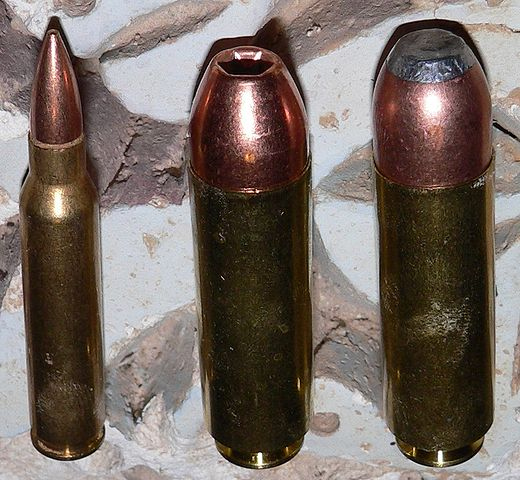
Pros & Cons
The .50 Beowulf is the one of the ultimate “wow” rifles. It kicks like hell on both ends and it creates a clap of thunder when your wallet slams empty as you buy the ammunition.
The .50 Beowulf is a decent choice for hunting as it’ll certainly drop anything in North America. Trajectory is a slight concern as is the cost and availability of ammunition.
It’s currently loaded by a few ammunition houses but lacks options with premium bullets for high performance hunting.
So you’ll have to get started reloading.
As a home defense round it serves no real niche. It’s huge but normally comes with hard & deep penetrating bullets. That would make this round just as effective as using an M855 5.56 round for home defense in the sense it would pass through the target quickly imparting little damage.
The key to using this behemoth is to get close and use a bullets that’ll reliably open up and dump all of its massive amounts of energy. The .50 Beowulf is a round that’ll stomp most anything that walks (or drives) in North America and impress all your friend to boot!
Find some great .50 Beowulf Uppers from the original maker, Alexander Arms.
Cartridges to Avoid
We’ve gone through some all-star AR-15 alternative cartridges…what are some to avoid?
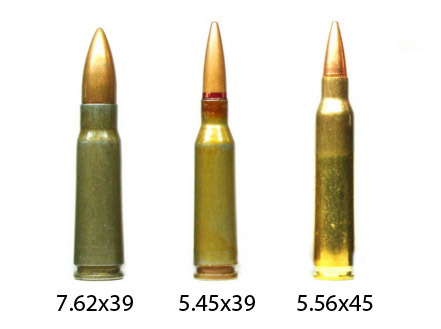
5.45x39mm
5.45×39 was Russia’s answer to the 5.56 M16 on the battlefield as the ammo source of the AK-74. It’s been regarded as black magic death and the reason for maimed soldiers since the late 70’s.
Rounds used by the Mujahadeen in Afghanistan were so lightly constructed that they ricocheted and blew up when they hit wall boards. The bullets didn’t penetrate well and they didn’t kill well, but they did get a reputation for nasty superficial wounding.
That’s where the round’s wide wounding and explosive-like myth came from.
The main selling point of this round was that in years past you could find cheap surplus ammo…but the supply has long dried up. This leaves the steel cased Tula Ammo and Wolf on the market, but using it can have negative implications in direct impingement guns.
I say skip the 5.45 and go back to the regular 5.56. You don’t gain anything in the AR-15 when you switch the 5.54×39 except a lighter wallet and a less useful weapon.
7.62x39mm
The real OG of intermediate rounds which fed the infamous AK-47, this was the cartridge that really kicked off the arms race of intermediate carbines. A true .30 caliber it launches 120gr bullets or so at close to 2200fps from a rifle length barrel.
Seems like a perfect round right?
Unfortunately…no.
The taper of this case makes it necessary for dramatically curved magazines and custom lower receivers to work well. It also mostly uses the steel cased ammunition that uses the polymer coating that doesn’t work the best in direct impingement guns.
The 7.62 doesn’t offer anything the growing .300 BLK does better and doesn’t come in nearly as many loads and isn’t readily suppressed. Skip this round and get the .300 BLK.
However, if you must…try to get a custom lower receiver (like the RRA) that accepts an AK-47 magazine and moves the pistol grip further back to make it easier to rock the magazine forward.
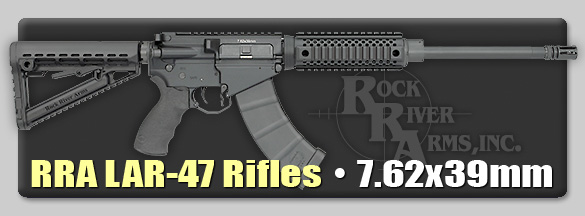
Conclusion
Choosing an alternative AR-15 cartridge is a balance between different sacrifices of power, cost, and availability.
The hardest part can be just taking the plunge and picking a cartridge. And realizing you might need to learn how to reload that expensive ammo.
Some rounds are still boutique and may disappear in the future (cough, cough…6.5 Grendel…) but for now they’re fantastic rounds if the purpose suits your mission.
It’s hard to read the tea leaves for which round will be the next super star. Choose the one you like best and shoot it until the barrel burn out.
In the meantime, which round do you think will be next for mass acceptance? Or have we persuaded you to just upgrade your 5.56 AR-15.
Learning Resources
Beginner’s Guide to Guns
The post Best Alternative AR-15 Cartridges and Calibers appeared first on Pew Pew Tactical.